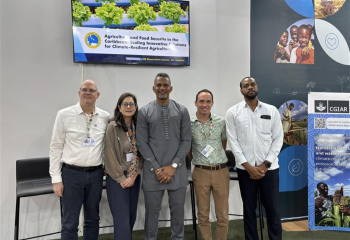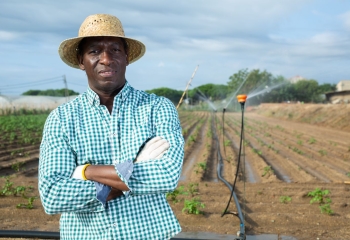Twenty years ago, when molten lava spewed from the Soufrière Hills volcano, it seemed no industry or sector in Montserrat had been left untouched by its destructive path.
Up until now, more than 70 local livestock farmers had continued to grapple with the effects of the devastation.
The volcano eruption in 1995 destroyed the island' only abattoir in the capital of Plymouth. With the slaughterhouse gone, livestock farmers found it hard to run their businesses.
But on January 22, 2016, the Montserrat Abattoir at Brades officially opened the door for better livelihoods for farmers. It was built with the support of the Caribbean Development Bank' Basic Needs Trust Fund (BNTF). BNTF provided a grant of USD400,000 and the Government of Montserrat USD100,000.
“We welcome this abattoir in Montserrat as a genuine investment in our farming community," said Hon. Claude Hogan, Minister of Agriculture, Trade, Lands, Housing and the Environment during the official opening event.
The Construction of the facility ends years of some farmers slaughtering animals in backyards or pasture areas—a practice that did not meet global food safety or manufacturing standards. It decreased health risks in poor communities where residents, opting to prepare meat for meals on their own, could get sick from handling raw meat and slaughtering animals in an uncontrolled environment.
In addition, having no local slaughterhouse impacted consumer confidence in locally produced meats and restricted shoppers to buying expensive imported varieties. The concerns about quality also ruled out any chance of developing a sustainable export market for the country' meat products.
The new Montserrat Abattoir makes way for new possibilities in sectors such as agriculture, hospitality and grocery retail, and it supports the Ministry of Agriculture' efforts to increase the production of pork, mutton and lamb.
It will have capabilities for manufacturing products such as hamburger patties, sausages and hams, boosting local business and the potential for exporting Montserrat-made foods.
“We'll be moving our meat products up the value chain and into our local super-markets in packaging just as good as the imported ones," said Minister Hogan.
Having a new abattoir also reduces the public health and safety risks for locals and visitors on whom Montserrat depends for revenue through the Tourism industry.
And, it secures the livelihoods of livestock farmers, butchers, restaurateurs and many others whose incomes depend on the presence of a safe facility for animal slaughtering and meat preparation.
The Government of Montserrat also committed to building capacity in the livestock sector. As part of the sub-project, the Ministry of Agriculture provided training for operators. They have learnt how to prepare animals for slaughter and techniques in meat handling, cutting, deboning and packaging.
The Ministry also agreed to enforce legislation concerning the rearing of livestock and the sale and disposal of meat products, and to launch a public awareness programme on public health.
Now that it has officially opened, it is clear that the slaughter facility at Brades, Montserrat is shaping up to be more than a building. For Montserratians, it symbolizes a long awaited positive turnaround in the island' livestock industry—one that is opening the gateway for better business and export opportunities, and making Montserrat meat safe to eat again.

